Soaking in Sudan
Published 7 years ago, updated 6 years ago
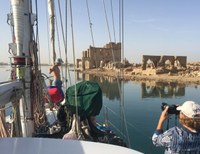

Suakin, Sudan
April 8, 2018
Before leaving Massawa, Eritrea, I emailed Mohammed, Suakin’s wonderful yacht service agent, via inReach SE satellite text of our pending arrival. He had arranged a tourist visa, hotel, and transportation for my brother who flew into Port Sudan from U.S. to join us. No commercial carrier offered flights to Khartoum, where visas are more expensive/complicated and U.S. State Dept considers the city a Level 3 security risk.
On arrival
We hailed Suakin Port Control on VHF Ch16 and 14 an hour before arrival. Not until 06h30 when we were almost at the entrance did we get a response, which after answering the standard questions (port of registry, size of yacht, number of crew and nationality, etc.), came immediate port entry permission and a kind welcome. Once well within the channel, we hugged the ruined city of Suakin Island (historical site) to avoid the shoals of the channel’s opposite (western) side. Nearing the end of the season, we were the only sailing yacht except for an unmanned yacht anchored and covered in Red Sea dust. We anchored just south of the island, before the fishing skiffs, in about 20’: good holding on mud bottom. We were so guarded from swell that below deck, I thought we were in a well-protected marina.
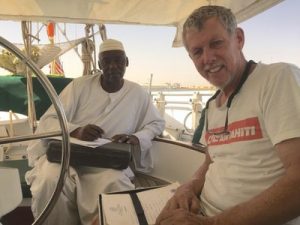

Clearing-in
Per my most recent email arrival estimate, the friendly Mr. Mohammed was there to greet us, fresh local bread in hand. His English is excellent. He’s tall, handsome, cheerful, and has a deep bass voice, features worthy of a character-actor movie career.
His white fiberglass panga/skiff served as our dinghy dock, from which he boarded our dinghy to our yacht, and efficiently collected our documents: 1 passport picture per person for the shore pass; 1 passport photocopy per person; 1 crew list.
Charge for clearing the four of us in, including his commission, $220 USD.
He returned with our shore passes within a couple hours.
Getting immediate services
Additionally we requested 600 liters of diesel (US$0.70 per liter delivered to shore in our gerry jugs), 2 10GB data SIM cards (US$15 ea), and to exchange US$140 (25 Sudanese pounds to the USD, an excellent exchange rate with the understanding that he’d buy back what we didn’t use). Our diesel jugs returned full within 3-4 hrs. Mohammad lent us his portable WiFi hotspot device gratis, so we could spread decent Internet joy among the crew installing one of the 2 SIM cards into the hotspot. (We hadn’t had Internet since leaving India, as Eritrea doesn’t really have anything useable).
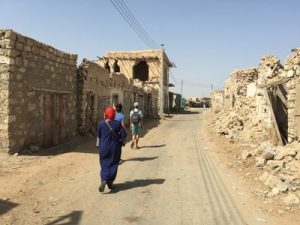

Tours, food and sights in Suakin
Visiting the Ruins of Suakin costs 10 Sudanese pounds per person (US$0.40) for an all-day pass. Each time we walked around, we bumped into a friendly local authority ready to describe the ruins in his best English; very kind. After visiting the local museum a few days later, a short taxi or motorized rickshaw drive away, we had greater appreciation for what we were seeing, how old the site was and how quickly it fell apart.
That evening, Mohammed drove us in his worn four-door Mercedes to an excellent local herb-grilled chicken restaurant. Reading how traditional Muslim Sudan is, whenever ashore, Leslie opted to wear her full body Muslim dress and head scarf so as not to draw too much-added glares against herself and the family in general. We saw many more men than women out at night (women made up only about 5% of those out after dark). Our tab for the delicious dinner of 4 chicken halves, 3 bean plates, fresh bread, 5 small water bottles and 2 Cokes was $14 total. No flatware or napkins, yet all food establishments have set up a water can with working spiget and a bar of soap to wash before and after. Air dry always.
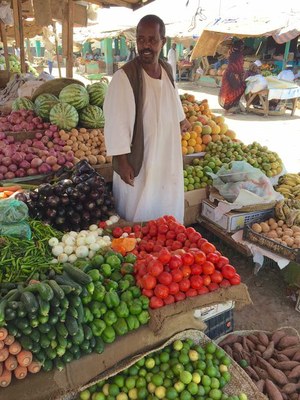

Mr. Mohammed answered all our questions and solved all our visiting requests. He was our dream official and guide. He drove us to the open market for fruits and vegetable provisioning, as well as shops that sold UHT boxed milk (for our growing teenagers), pasta, and canned goods. He then drove our provisions and us back to the “dinghy dock.” He found a replacement 30l gerry jug for one of ours which its lid no longer held tight. And he arranged a taxi fellow in Port Sudan to act as a city tour guide (Mr. Gafar’s English not so good, so he called Mohammed to clarify whenever necessary. It worked fine). We took a 1hr public bus from Suakin to Port Sudan (US$1/pp). Mr Gafar met up with us and drove us around the port, took us to a fish market, to a wonderfully rustic restaurant for grilled lamb, and an open market for more fruits and vegetables, (we didn’t know how to ask to see the handicrafts bazaar), and drove us back to Suakin Island. There, he took us to the museum and to an awesome local bazaar to buy smaller aluminum jebbanas for serving Sudanese coffee. Total cost for driving us all around: $20.
Leslie and the boys decided to relax on the boat, while my brother, Nick and I went ashore to find some local dinner adventure. We stumbled across a small popular shack serving among other items a traditional bean dish, sprinkled with cheese, topped with fresh chopped tomatoes, onions, and greens, as well as a medium spicy oil sauce. They called it the “special.” Served with the local leavened pita-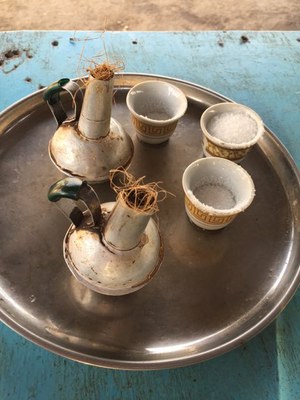

Early the next morning, Nick and I went to a flimsy blue coffee shack Mohammed recommended and enjoyed strong ginger-flavored Turkish-style coffee served from a small aluminum jebbana, complete with a filter of dried grass stuffed in the jebbana’s spout. The ceramic shot glasses were half filled with granulated sugar. We spoke in informal international hand language. Flies, goats, donkeys, cats, hawks, local stares, dirt floors, rickety old timber construction, table about to fall down… Loved it!!!
Clearing-out
Clearing out with Mohammed was equally as simple. The cost was low, don’t remember because the 30l jug filled with diesel was included in the overall price.
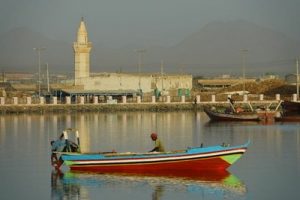

Conclusion
According to Mohammed, our Sudanese yacht agent/service provider, we were one of 28 boats this season to stop in Suakin. We heard from Mike in Massawa that only 18 had stopped in Eritrea. With Mohammed’s help, nothing was simpler, easier, and more enjoyable than stopping in Suakin, Sudan. He really made it a great experience.
If you have more time to visit the interior, I heard directly from the Sudanese Red Sea State Governor that you might wish to see Sudan’s pyramids, precursor to the larger, newer Egyptian “copies.” If you want to scuba dive, you need to make arrangements ahead of time through the dive companies in Port Sudan. Most scuba operating boats are “live-aboard,” meaning you stay on board the whole time for a week at a time. We didn’t dive because all the boats were booked and there were no day trips available. We don’t carry our own dive equipment on Kandu . . . just no space.
Local Cruising Tips for Egypt and Suez
Before leaving Suakin, Mohammed highly recommended we meet with Jacques, a Frenchman who has sailed these parts for 14 years. Jacques was preparing to leave for Suez and the Med the same day we were planning to leave for Port Ghalib, Egypt. He gave us terrific advice on where to stop, and where not to stop, maximizing joy and minimizing agony.
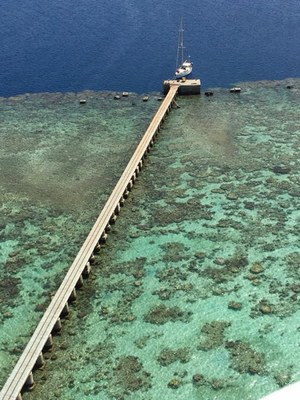

1) On the way to Egypt, stop at Sanganeb Reef & lighthouse to snorkel, buy a T-Shirt (US$15 ea. supports the workers), and tour the lighthouse.
Our pilot guide recommended that, if just snorkelling, we avoid anchoring in the lagoon and simply tie off from the end of the lighthouse’s concrete pier, which we did. We simply tied up to the lighthouse pier’s bollard for a couple hours as the current and wind gently kept the boat off the pier (see photo). We later learned that two boats just two weeks ahead of us had anchored in the lagoon. One lost his anchor and the other barely recovered theirs. As we walked the long length of pier from Kandu toward the lighthouse, members of the Sudan Red Sea state’s Governor’s entourage invited us to join them for coffee and tea. They were not deterred by our wet snorkelling outfits and were as curious about us as we were of them. After a lengthy exchange and a song or two from Leslie, they asked for a group picture and were off to their boat. We then proceeded to tour the lighthouse, buy our T-shirts, and cast off our bow lines . . . a fantastic, serendipitous experience.
2) Check into Port Ghalib, cheaper, faster, and friendlier. Make arrangements with one of the two Egyptian Suez Canal agents before proceeding. Visit Luxor.
3) Skip Hurghada where a new bureaucrat charges boats a lot to check in again and all other costs are high.
4) Check/clear out of Port Suez after visiting the pyramids.
5) Stop in Ismailia, required anyway, and visit the wonderful yacht club but don’t leave it to go further ashore as we would have already cleared out of Egypt from Port Suez. Stay until the weather is good, but hopefully spend a couple days at the club: laundry, showers, etc. Hire a pilot.
6) Drop the pilot off in Port Said, but for the sake of your boat, sanity, and wallet (damage due to ship’s wake, clearing out is harder, more expensive, etc.), keep on going, preferably to Cyprus. From there, cheap flights can take you to the rest of the eastern Med for a lot less money and hassle than arriving by boat.
Related content
Related to following destinations: Port Suakin, Port Sudan, Sudan



